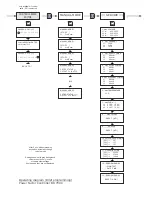
CONTROL PRINCIPLE
The control behavior can be selected in the programming mode. Generally, the BR7000
offers different possibilities of controlling:
˜
SEQUENTIAL CONNECTION
In sequential connection, the required capacitor stages are successively
connected or disconnected step by step (last in first out).The ranking of each
step always corresponds to the power of the smallest stage.
Advantage: exact definition of the next capacitor to be connected in each case.
Disadvantage: long reaction time, high switching frequency of small stages,
uneven strain on the capacitors.
In order to shorten the setting times nevertheless, the BR7000 simultaneously
switches several steps in case a higher power factor correction is required.
This applies to all control modes.
The maximum size of the simultaneously switched branches can be changed in
EXPERT-MODE 1. If the value of the smallest stage is pre-selected, the
conventional sequential connection is obtained.
˜
LOOP CONNECTION
In this variant, the controller operates in loop connection (first in - first out)
which minimizes the wear off of the system. E.g. in case of stages of same
value always the stage that has been disconnected for the longest time is
connected next.
Advantage: even utilization of stages, increase of life time of system.
Disadvantage: only effective for control series with groups of same stage
power, long reaction times.
˜
INTELLIGENT (Factory setting)
The intelligent control principle combines the advantages of the system-saving
loop connection (first in first out) with a significantly higher setting time even in
case of high load skips, and reaches this target with the fewest possible
switching operations of capacitor steps. The optimized time behavior is reached
by simultaneous switching of several or larger capacitor groups depending on
the missing reactive power in the grid. Additionally, the number of real
switchings of the capacitors as well as switch-in times of the branches are
considered.
Advantage: Reaching of target cos-phi in fast, optimized setting times in
combination with a low switching frequency of the capacitor.
˜
COMBINED DE-TUNING
(Special case for combined de-tuned systems)
Pair wise de-tuning requires an appropriate control series (e.g. 1:1:1:1...,
1:1:2:2:..., 1:1:2:2:4:4...). The condition for the switching behavior is defined
in a way that the number of connected odd steps always is higher or equal to the
number of connected even steps. The controller fulfills the requirements in the
control regime whilst largely conforming to the switching behavior.
- 30 -














































